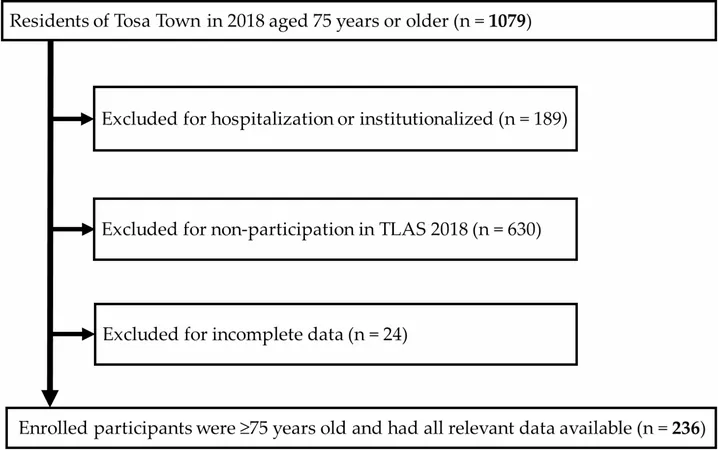
Chew On This: The Unseen Connection Between Masticatory Function and Sarcopenic Obesity in Seniors Revealed!
2025-03-22
Author: Nur
A New Look at Seniors' Health: Exploring Masticatory Function and Its Impact
The link between our ability to chew and a growing concern in geriatric health—sarcopenic obesity—remains a murky area of study. Recent research has unveiled crucial insights into this relationship among community-dwelling seniors aged 75 and older.
Study Overview: Understanding the Research
In a comprehensive analysis involving 236 older adults, researchers set out to investigate how masticatory function—essentially how well one can chew—affects the prevalence of sarcopenic obesity. Sarcopenic obesity is a dual concern characterized by the combination of muscle loss (sarcopenia) and excess body fat.
To assess chewing ability, participants chewed special color-changeable gum, with experts measuring the color difference before and after chewing. This innovative approach helped categorize masticatory function into low, intermediate, and high levels.
Key Findings: A Clear Link Uncovered
The findings were striking. Among participants, the prevalence rates for obesity, sarcopenia, and sarcopenic obesity stood at 15.3%, 24.2%, and 9.7%, respectively. The research revealed that those with high masticatory function were significantly less likely to exhibit signs of sarcopenic obesity (posterior estimate of -1.83) and sarcopenia (posterior estimate of -1.97) compared to those with lower chewing capability. Intriguingly, there was no significant association noted between chewing function and general obesity, suggesting that the strength of one’s bite may not directly correlate with sheer body weight.
Project Specifics: The Study’s Foundation
Conducted as part of the Tosa Longitudinal Aging Study in Japan, the research carefully excluded hospitalized individuals and focused on community residents. A robust sample size of 236 participants emerged after thorough data collection, ensuring diverse representation from the local aging population.
Implications of the Findings: Why Masticatory Function Matters
The implications of the study are profound. Higher chewing capabilities may support improved nutritional intake—an essential component in maintaining muscle mass and combating sarcopenic obesity. The study highlighted that individuals with better masticatory function often enjoy a broader dietary diversity, contributing to their overall health.
Moreover, previous studies suggest that reduced chewing ability can limit food choices, thereby lowering protein and essential vitamin intake—factors crucial for muscle health.
The Muscle Connection: How Chewing Affects Strength and Quality of Life
Exploring the mechanisms behind these findings, researchers speculate that masticatory function may correlate with both muscle quality and strength. Factors like muscle inflammation from obesity and reduced strength due to muscle loss suggest that better chewing ability could not only enhance dietary intake but also bolster muscle maintenance in older adults.
Limitations and the Need for Further Research
While the study brings promising insights, limitations exist. The participant pool represented only a fraction of older adults in the region, which may skew the broader applicability of the findings. Moreover, the cross-sectional nature of the study prevents establishing causal relationships between masticatory function and sarcopenic obesity.
Final Thoughts: The Importance of Chewing for Healthier Living
This research underscores the critical role masticatory function may play in aging populations, potentially serving as a protective factor against sarcopenic obesity. Ensuring that older adults maintain their chewing abilities could dramatically impact their quality of life and overall health, potentially leading to lower healthcare costs.
In summary, these findings call for awareness of the importance of oral health in the elderly—chew wisely, live well!


 Brasil (PT)
Brasil (PT)
 Canada (EN)
Canada (EN)
 Chile (ES)
Chile (ES)
 Česko (CS)
Česko (CS)
 대한민국 (KO)
대한민국 (KO)
 España (ES)
España (ES)
 France (FR)
France (FR)
 Hong Kong (EN)
Hong Kong (EN)
 Italia (IT)
Italia (IT)
 日本 (JA)
日本 (JA)
 Magyarország (HU)
Magyarország (HU)
 Norge (NO)
Norge (NO)
 Polska (PL)
Polska (PL)
 Schweiz (DE)
Schweiz (DE)
 Singapore (EN)
Singapore (EN)
 Sverige (SV)
Sverige (SV)
 Suomi (FI)
Suomi (FI)
 Türkiye (TR)
Türkiye (TR)
 الإمارات العربية المتحدة (AR)
الإمارات العربية المتحدة (AR)